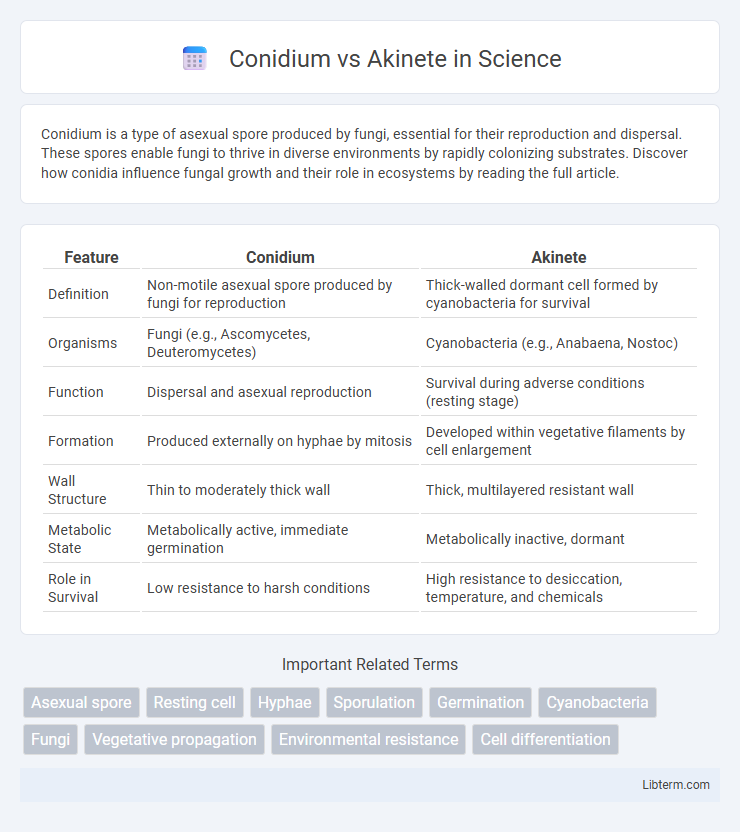Conidium is a type of asexual spore produced by fungi, essential for their reproduction and dispersal. These spores enable fungi to thrive in diverse environments by rapidly colonizing substrates. Discover how conidia influence fungal growth and their role in ecosystems by reading the full article.
Table of Comparison
| Feature | Conidium | Akinete |
|---|---|---|
| Definition | Non-motile asexual spore produced by fungi for reproduction | Thick-walled dormant cell formed by cyanobacteria for survival |
| Organisms | Fungi (e.g., Ascomycetes, Deuteromycetes) | Cyanobacteria (e.g., Anabaena, Nostoc) |
| Function | Dispersal and asexual reproduction | Survival during adverse conditions (resting stage) |
| Formation | Produced externally on hyphae by mitosis | Developed within vegetative filaments by cell enlargement |
| Wall Structure | Thin to moderately thick wall | Thick, multilayered resistant wall |
| Metabolic State | Metabolically active, immediate germination | Metabolically inactive, dormant |
| Role in Survival | Low resistance to harsh conditions | High resistance to desiccation, temperature, and chemicals |
Introduction to Conidium and Akinete
Conidia are asexual, non-motile spores produced by fungi that facilitate rapid dispersal and colonization in favorable environments. Akinetes are thick-walled, dormant resting cells formed by cyanobacteria to survive adverse conditions such as desiccation or nutrient depletion. Both structures serve as survival and reproduction mechanisms, with conidia emphasizing propagation and akinetes emphasizing endurance.
Definition of Conidium
Conidium is an asexual, non-motile spore produced by fungi, particularly Ascomycetes, serving as a primary means of reproduction and dispersal. Unlike akinetes, which are thick-walled dormant cells found in cyanobacteria enabling survival under adverse conditions, conidia facilitate rapid propagation in favorable environments. The formation of conidia occurs via mitosis, allowing fungi to colonize substrates efficiently without sexual reproduction.
Definition of Akinete
Akinetes are thick-walled, dormant cells formed by certain filamentous cyanobacteria, designed to survive adverse environmental conditions by storing nutrients and resisting desiccation. Unlike conidia, which are asexual spores produced by fungi for dispersal and reproduction, akinetes function primarily as survival structures rather than reproductive units. Their dense cytoplasm and thick cell walls provide long-term viability until favorable growth conditions return.
Structural Differences Between Conidium and Akinete
Conidia are asexual, non-motile spores produced externally on specialized hyphae called conidiophores, characterized by thin walls and rapid dispersal capability. Akinetes are thick-walled, dormant spores formed within the filamentous cells of cyanobacteria, designed for survival under adverse environmental conditions. The key structural difference lies in conidia's thin, delicate walls for immediate reproduction versus akinetes' robust, multi-layered walls for long-term protection.
Origin and Formation
Conidia are asexual spores produced by fungi through mitotic division, originating on specialized hyphal structures called conidiophores. Akinetes form in cyanobacteria as thick-walled dormant cells, developing from vegetative cells under adverse environmental conditions. Both serve as survival structures but differ significantly in cellular origin and formation processes.
Ecological Roles and Functions
Conidia serve primarily as asexual spores facilitating rapid fungal dispersal and colonization in diverse ecological niches, enhancing survival in fluctuating environmental conditions. Akinetes function as thick-walled dormant cells produced by cyanobacteria, enabling persistence through adverse conditions like desiccation and nutrient scarcity. Both structures contribute to microbial community dynamics by ensuring species continuity and ecosystem stability under environmental stress.
Survival Strategies and Resistance
Conidia are asexual spores produced by fungi that enable rapid dispersal and colonization in favorable conditions, offering moderate survival capability against environmental stress. Akinetes are thick-walled dormant cells formed by cyanobacteria, specifically adapted for long-term survival under adverse conditions like desiccation, cold, and nutrient depletion. The resistance of akinetes to harsh environmental factors is significantly higher than that of conidia, providing cyanobacteria a strategic advantage for persistence in fluctuating ecosystems.
Reproductive Importance
Conidia function as asexual spores that enable rapid and widespread reproduction in many fungi, facilitating quick colonization and genetic dispersal. Akinetes serve as thick-walled dormant cells primarily in cyanobacteria, ensuring survival during unfavorable environmental conditions and resuming active growth when conditions improve. The reproductive importance of conidia lies in their role in proliferation and infection, whereas akinetes are crucial for long-term species persistence through environmental stress.
Examples in Nature
Conidia and akinetes serve as reproductive structures in fungi and cyanobacteria, respectively, each adapted to their specific environments. Conidia are asexual spores produced by fungi such as Aspergillus and Penicillium species, facilitating rapid dispersion and colonization in terrestrial habitats. In contrast, akinetes are thick-walled dormant cells formed by cyanobacteria like Anabaena and Nostoc, enabling survival during unfavorable aquatic conditions such as drought or nutrient scarcity.
Key Differences Summarized
Conidia are asexual, non-motile fungal spores produced externally on conidiophores, primarily for dispersal and rapid reproduction. Akinetes are thick-walled, dormant spores formed within cyanobacteria cells to withstand harsh environmental conditions and ensure survival. Unlike conidia, akinetes serve as resting spores with nutrient reserves, enabling long-term persistence rather than immediate propagation.
Conidium Infographic

 libterm.com
libterm.com